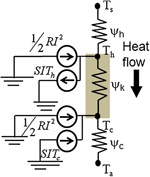Crossref Citations
This article has been cited by the following publications. This list is generated based on data provided by
Crossref.
Yazawa, Kazuaki
and
Shakouri, Ali
2013.
Cost–Performance Analysis and Optimization of Fuel-Burning Thermoelectric Power Generators.
Journal of Electronic Materials,
Vol. 42,
Issue. 7,
p.
1946.
Yazawa, Kazuaki
Hao, Menglong
Wu, Bin
Silaen, Armin K.
Zhou, Chenn Qian
Fisher, Timothy S.
and
Shakouri, Ali
2014.
Thermoelectric topping cycles for power plants to eliminate cooling water consumption.
Energy Conversion and Management,
Vol. 84,
Issue. ,
p.
244.
Reddy, B. V. K.
Barry, Matthew
Li, John
and
Chyu, Minking K.
2014.
Convective Heat Transfer and Contact Resistances Effects on Performance of Conventional and Composite Thermoelectric Devices.
Journal of Heat Transfer,
Vol. 136,
Issue. 10,
Bahk, Je-Hyeong
Fang, Haiyu
Yazawa, Kazuaki
and
Shakouri, Ali
2015.
Flexible thermoelectric materials and device optimization for wearable energy harvesting.
Journal of Materials Chemistry C,
Vol. 3,
Issue. 40,
p.
10362.
Koh, Yee Rui
Yazawa, Kazuaki
and
Shakouri, Ali
2015.
Performance and mass optimization of thermoelectric microcoolers.
International Journal of Thermal Sciences,
Vol. 97,
Issue. ,
p.
143.
Jing, Hongyang
Li, Yuan
Xu, Lianyong
Han, Yongdian
Lu, Guoquan
and
Zhang, Hao
2015.
Interfacial Reaction and Shear Strength of SnAgCu/Ni/Bi2Te3-Based TE Materials During Aging.
Journal of Materials Engineering and Performance,
Vol. 24,
Issue. 12,
p.
4844.
Yazawa, Kazuaki
and
Shakouri, Ali
2016.
Thermoelectric topping cycles with scalable design and temperature dependent material properties.
Scripta Materialia,
Vol. 111,
Issue. ,
p.
58.
Barry, Matthew M.
Agbim, Kenechi A.
Rao, Parthib
Clifford, Corey E.
Reddy, B.V.K.
and
Chyu, Minking K.
2016.
Geometric optimization of thermoelectric elements for maximum efficiency and power output.
Energy,
Vol. 112,
Issue. ,
p.
388.
Yazawa, Kazuaki
and
Shakouri, Ali
2016.
Thermal optimization of embedded thermoelectric generators in refractory furnaces.
p.
1489.
Yazawa, Kazuaki
Shakouri, Ali
and
Hendricks, Terry J.
2017.
Thermoelectric heat recovery from glass melt processes.
Energy,
Vol. 118,
Issue. ,
p.
1035.
Abid, Muhammad
Somdalen, Ragnar
and
Rodrigo, Marina Sancho
2018.
Design Optimization of a Thermoelectric Cooling Module Using Finite Element Simulations.
Journal of Electronic Materials,
Vol. 47,
Issue. 8,
p.
4845.
Yazawa, Kazuaki
and
Shakouri, Ali
2021.
Fuel-burning thermoelectric generators for the future of electric vehicles.
Energy Conversion and Management,
Vol. 227,
Issue. ,
p.
113523.
Rösch, Andres Georg
Franke, Leonard
Mallick, Md. Mofasser
and
Lemmer, Uli
2023.
Optimizing printed thermoelectric generators with geometry and processibility limitations.
Energy Conversion and Management,
Vol. 279,
Issue. ,
p.
116776.
Zhu, Xingzhuang
Zuo, Zhengxing
Wang, Wei
Jia, Boru
and
Zhan, Tianzhuo
2023.
Experimental research and optimization of a thermoelectric generator excited by pulsed combustion mode under limited heat dissipation for combined heat and power supply.
Applied Energy,
Vol. 349,
Issue. ,
p.
121668.





